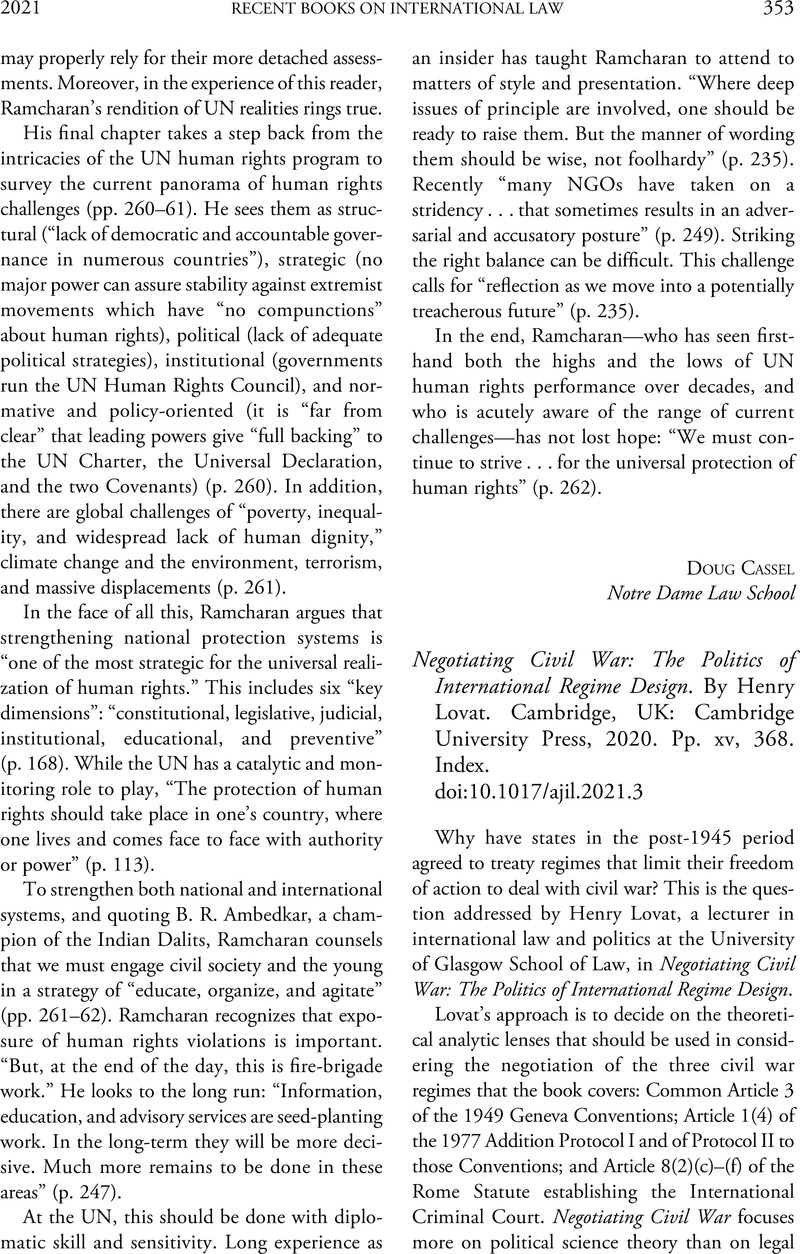No CrossRef data available.
Published online by Cambridge University Press: 19 April 2021

1 For example: “Typological theorising, for example, provides a structured means of identifying and organising theoretical traditions and insights to combine in analysis, by reference to the ‘property space’ of insights derived from multiple IR theoretical approaches” (p. 23).
2 Common Article 3 of each of the four 1949 Geneva Conventions can be found at https://ihl-databases.icrc.org/applic/ihl/ihl.nsf/vwTreaties1949.xsp.
3 The ICRC reports on the government experts conferences are available at https://www.loc.gov/rr/frd/Military_Law/RC-confer_govern_experts.html and https://www.loc.gov/rr/frd/Military_Law/pdf/RC-Report-conf-of-gov-experts-1972_V-1.pdf.
4 The records of the diplomatic conference are available at https://www.loc.gov/rr/frd/Military_Law/RC-dipl-conference-records.html. More generally, Geneva Conventions materials are available at https://www.loc.gov/rr/frd/Military_Law/Geneva-Conventions_materials.html.
5 Protocol Additional to the Geneva Conventions of 12 August 1949, and Relating to the Protection of Victims of International Armed Conflicts (Protocol I), Art. 1, June 8, 1977, 1125 UNTS 3, at https://ihl-databases.icrc.org/applic/ihl/ihl.nsf/Article.xsp?action=openDocument&documentId=6C86520D7EFAD527C12563CD0051D63C.
6 The U.S. delegation report says Western countries like the United States and Canada wanted a low threshold and basic humanitarian provisions while countries like Norway and Finland wanted provisions paralleling Protocol I, and that developing countries consistently feared a protocol on NIACs would lessen their ability to suppress rebellion. “Perhaps the worst combination of results was achieved”—relatively rigorous provisions and a high threshold, dealing the goal of strengthening the law applicable to NIACs “a serious blow.” Report of the United States Delegation to the Diplomatic Conference on the Reaffirmation and Development of International Humanitarian Law Applicable in Armed Conflict, Second Session, submitted to the Secretary of State on July 18, 1975, by George H. Aldrich, prepared by Ronald J. Bettauer, at 30–31. Lovat refers to the 1975 and 1976 reports of the U.S. Delegation, but not to the delegation reports concerning the other two sessions of the diplomatic conference or concerning the two the government experts meetings. Excerpts from the U.S. delegation reports are also at 1974 Dig. U.S. Prac. Int'l L. 701 (1974); 1975 Dig. U.S. Prac. Int'l L. 803 (1975); 1976 Dig. U.S. Prac. Int'l L. 681 (1976); and 1977 Dig. U.S. Prac. Int'l L. 918 (1977). Lovat cites one U.S. delegation reporting cable; the practice was to send a reporting cable at least once a week during diplomatic conference, each session of which lasted months. There are a few relatively minor factual inconsistencies between the Lovat narrative and the U.S. delegation reports, e.g., on the number of states that participated in some of the conferences.
7 Protocol I, supra note 5, Art. 96.
8 The U.S. delegation report calls the redraft of Protocol II the “most dramatic development in the Final Plenary Sessions,” noting that while it was likely that the two-thirds vote requirement would result in some reduction of the draft as reported by the conference committees, the “drastic surgery . . . was not foreseen.” Report of the United States Delegation to the Diplomatic Conference on the Reaffirmation and Development of International Humanitarian Law Applicable in Armed Conflict, Fourth Session, submitted to the Secretary of State on September 8, 1977, by George H. Aldrich, at 27 [hereinafter 1977 U.S. Delegation Report]. In his closing statement, Aldrich said the United States was “disappointed” at the relatively high threshold, which could be a “convenient excuse” to refuse to admit applicability.” Id., Appendix D, at 6.
9 By quoting a New Zealand comment, Lovat implies he agrees that the U.S. delegation chair for the negotiation of the Additional Protocols “though alert and articulate, had little experience of, or feeling for, multilateral diplomacy” (p. 158). In fact, the U.S. delegation chair had deep experience. It seems gratuitous to pass on a second-hand subjective criticism of this type. The U.S. delegation chair's feeling for multilateral diplomacy can be seen in his observation that “a perhaps vital” “element of our [U.S.] success was our constant concern to identify and meet, insofar as possible, the real needs of other Conference participants. Given sufficient time and effort, it was usually possible to arrive at a solution to any particular problem that met at least the minimum requirements of virtually all delegations.” 1977 U.S. Delegation Report, supra note 8, at 30.
10 Id. at 32; Appendix D, at 4–5.
11 Rome Statute of the International Criminal Court, Art. 8, July 17, 1998, at https://www.icc-cpi.int/resourcelibrary/official-journal/rome-statute.aspx#article8.
12 Prosecutor v. Tadić, Case No. IT-94-1-I, Decision on the Defence Motion for Interlocutory Appeal on Jurisdiction, (Int'l Crim. Trib. former Yugoslavia Oct. 2, 1995), at https://www.icty.org/x/cases/tadic/acdec/en/51002.htm (cited by Lovat at p. 211).
13 ICTR Statute, adopted by S/RES/955, Art. 4 (1994), at https://undocs.org/S/RES/955(1994) (cited by Lovat at pp. 210–11).
14 This reviewer, at that time an attorney in the State Department Office of the Legal Adviser, coordinated the position papers for the 1971–1976 conferences and was a member of the U.S. delegation to those conferences, representing the United States on one of the conference main committees.